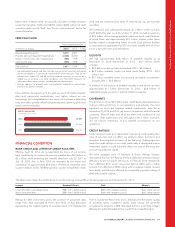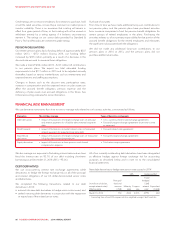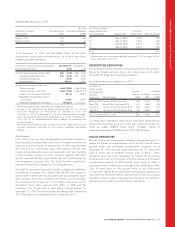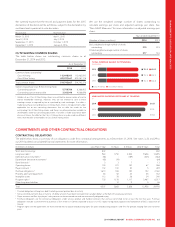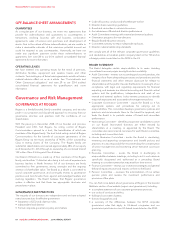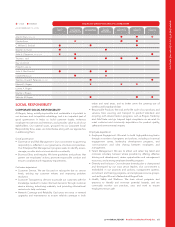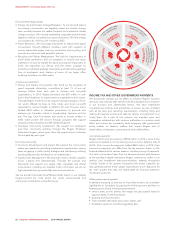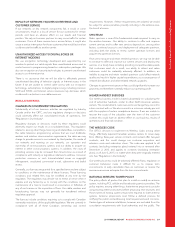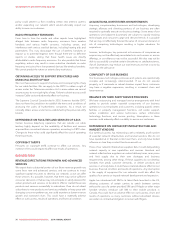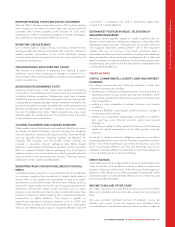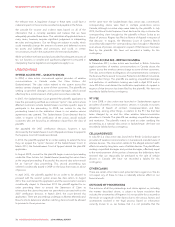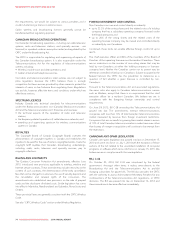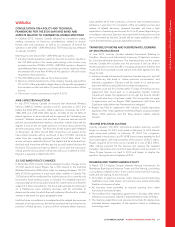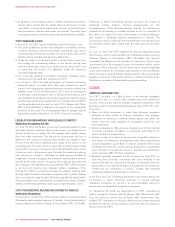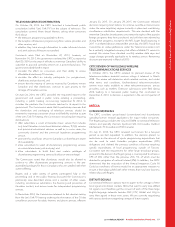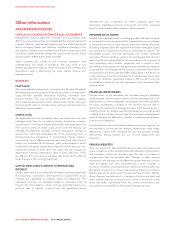Rogers 2014 Annual Report Download - page 72
Download and view the complete annual report
Please find page 72 of the 2014 Rogers annual report below. You can navigate through the pages in the report by either clicking on the pages listed below, or by using the keyword search tool below to find specific information within the annual report.MANAGEMENT’S DISCUSSION AND ANALYSIS
Poor economic conditions can also have an impact on our pension
plans because there is no assurance that the plans will be able to earn
the assumed rate of return. Capital market volatility may result in
changes in the discount rates and other variables used to calculate our
pension obligations, requiring us to make contributions in the future
that differ significantly from current contributions and assumptions
being used in the actuarial valuation process.
SUBSTANTIAL COMPETITION
There is no assurance that our current or future competitors will not
provide services that are superior to ours or at lower prices, adapt
more quickly to evolving industry trends or changing market
requirements, enter markets we operate in, or introduce competing
services. Any of these factors could reduce our business market share
or revenues, or increase churn.
We may have some ongoing re-pricing of products and services with
our existing subscribers as we may need to extend lower wireless
pricing offers to attract and retain customers. As wireless penetration of
the population deepens, new wireless customers may generate lower
average monthly revenue and this could slow revenue growth.
Wireless could face increased competition due to recent changes to
foreign ownership and control of wireless licences:
• Foreign telecommunication companies could enter the Canadian
market by acquiring wireless licences or a holder of wireless
licences. If companies with significantly greater capital resources
enter the Canadian market, it could reduce our wireless market
share. See “Foreign ownership and control” in “Regulation in Our
Industry” for details.
• Industry Canada’s policy regarding the transfer of spectrum licences,
combined with 2012 legislation that allows foreign ownership of
wireless providers with less than 10% market share, could make it
harder for incumbent wireless carriers to acquire additional
spectrum, including the completion of our previously announced
arrangements with Shaw and Videotron, while making it less
expensive for foreign wireless carriers to enter the Canadian wireless
market. This could increase the intensity of competition in the
Canadian wireless sector.
In addition, the CRTC Broadcasting Distribution Regulations do not
allow cable operators to obtain exclusive contracts in buildings where it
is technically feasible to install two or more transmission systems.
TECHNOLOGY RISKS
COMPETING TECHNOLOGIES
Several technologies may affect the way our services are delivered,
including:
• Broadband;
• IP-based voice, data and video delivery services;
• increased use of optical fibre technologies to businesses and/or
residences; and
• broadband wireless access and wireless services using a radio
frequency spectrum to which we may have limited access.
These technologies may also lead to significantly different cost
structures for users and therefore affect the long-term viability of some
of our current technologies. Some of the new technologies may allow
competitors to enter our markets with similar products or services at
lower costs. These competitors may also be larger and have greater
access to financial resources than Rogers.
Improvements in the quality of streaming video over the Internet,
coupled with the increasing availability of television shows and movies
online through OTT content providers, which compete for viewership,
are anticipated to increase competition for Canadian cable television
systems. If advances in technology are made to any alternative
Canadian multi-channel broadcasting distribution system, our cable
services may face increased competition. In addition, wireless Internet
is, in some instances, replacing traditional wireline Internet as the
technology for wireless Internet continues to develop.
The use of PVRs could affect our ability to generate television
advertising revenues because viewers can skip advertising aired on the
television networks. The continued emergence and growth of
subscriber-based satellite and digital radio products could change
radio audience listening habits and have a negative effect on the
results of our radio stations. Certain audiences are also migrating away
from traditional broadcast platforms to the Internet as more video and
audio content streaming becomes available.
DEPENDENCE ON INFORMATION TECHNOLOGY
SYSTEMS
Our businesses depend on information technology systems for day-to-
day operations. If we are unable to operate our systems or make
enhancements to accommodate customer growth and new products
and services or our systems go down, it could have an adverse effect
on our ability to acquire new subscribers, service customers, manage
subscriber churn, produce accurate and timely subscriber invoices,
generate revenue growth and manage operating expenses. This could
have an adverse impact on our results and financial position.
Most of our employees and critical elements of our network
infrastructure and information technology systems are concentrated in
various physical facilities. If we cannot access one or more of these
facilities because of a natural or manmade disaster or otherwise, our
operations may be significantly affected to the extent that it may be
difficult for us to recover without a significant interruption in service or
negative impact to our revenue or customer base.
INFORMATION SECURITY RISK
Security is essential to maintaining efficient, reliable business processes
and to enabling sustained business growth. Technology
advancements and the people using these technologies introduce
new information security risks. Cyber threats are maturing with time
and their sophistication and effectiveness are increasing. A security
breach could result in loss of revenue, reputation, and resources, or
handing advantage to a competitor.
We use standard industry practices for network and information
technology security, survivability and disaster recovery. Our ongoing
success partly depends on protecting our corporate business-sensitive
data, including personal information about our customers and
employees. We treat this information as intellectual property and
protect it from unauthorized access and compromise. We rely on our
policies and procedures and information technology systems to
protect this information. If we do not secure our data and the privacy of
our customer information, we may not be in compliance with
regulatory standards and it could result in negative publicity, litigation
and damage to our reputation. Any of these outcomes can cause us to
lose customers or public confidence, or experience financial losses.
68 ROGERS COMMUNICATIONS INC. 2014 ANNUAL REPORT



